
Sally Sparrow
About the Author
Sally studies art history in college, and as a hobby she learns numismatics. Her main historical specialization allows her to dig deeper into coin designs, their meanings and tiny details. In this blog, Sally shares her discoveries and documents her way in coinage studies. By the way, she gives advice to those who just start their new hobby and look for hints from more experienced numismatists. Stay there if you are curious about even everyday things!
Connect with Sally



Why Pay Attention to Bicentennials?
The humble U.S. quarter has rarely captured public imagination quite like the 1776-1976 Bicentennial quarter. Minted to commemorate 200 years of American independence, these coins stand out with their distinctive colonial drummer boy design and dual-dated obverse. But are bicentennial quarters worth anything? We will get to know it in this blog, so keep reading.
How many bicentennial quarters were made? This design has over 1.6 billion strikes, which makes them one of the most common commemorative coins in U.S. history. Therefore, for most of them, the value of bicentennial quarters is around their face — just 25 cents. Certain rare varieties and high-grade examples can command impressive premiums today. In fact, stories abound of Bicentennial quarters selling for thousands—and some dubious reports even suggest one may be worth a staggering $1.4 billion!
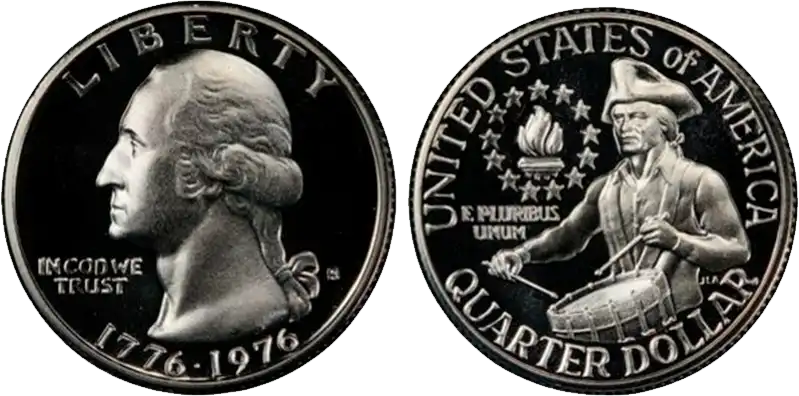
Overview of Bicentennial Quarters
Let’s start from the basics. Here is the main info about the coin’s appearance, its story, and key characteristics you should know to recognize it.
Years Minted
Although they commemorate the year 1776, all Bicentennial quarters were actually produced in 1975 and 1976. Interestingly, none of these coins display a 1975 date; they were all dual-dated “1776-1976” to mark the bicentennial of the U.S. Declaration of Independence.
Design
- Obverse (Heads): The obverse retains the familiar portrait of George Washington, designed by John Flanagan.
- Reverse (Tails): The reverse features a colonial drummer boy standing proudly with a victory torch encircled by 13 stars, representing the original colonies. This inspiring design was created by artist Jack L. Ahr, whose initials (JLA) appear discreetly on the coin.
This unique reverse replaced the standard eagle for two years, making these coins instantly recognizable.
Purpose
The 1776-1976 quarters were part of a broader bicentennial coinage program that included special editions of quarters, half dollars, and dollar coins. Authorized by Congress, this program aimed to:
- Celebrate the nation’s 200th anniversary.
- Foster public interest in coin collecting.
- Promote patriotic spirit during a time of great national reflection.
More than just pocket change, these coins were intended to become lasting symbols of American history and unity.
Types of Bicentennial Quarters
Rare bicentennial quarters worth money are not common, and understanding how the price forms is essential if you take collecting seriously. Here is some basic introductory info to understand which bicentennial quarters are worth money and which ones can be used as change.
The U.S. Mint produced two distinct types of these coins—clad quarters for general circulation and 40% silver quarters for collectors. Understanding the difference is key if you are hunting for bicentennial quarters rare value.
Clad Quarters (Copper-Nickel)
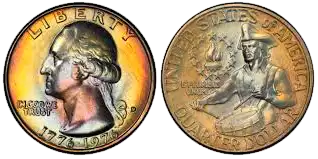
Composition:
- 75% copper, 25% nickel over a pure copper core.
- Weight: 5.67 grams.
Mint Marks:
- No mint mark = Philadelphia Mint (most common).
- “D” = Denver Mint (slightly scarcer but still common).
Value:
| Condition | Approximate Value |
| Circulated | $0.25–$1 |
| Uncirculated (MS-65 or higher) | $2–$10 |
While most of them are still worth just 25 cents, well-preserved uncirculated examples and valuable rare bicentennial quarters can make a few dollars or more—especially if graded by a reputable third-party service.
Silver Quarters (40% Silver)
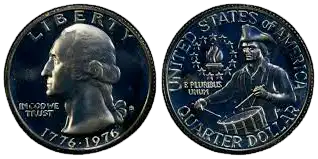
Composition:
- 40% silver, 60% copper core.
- Weight: 5.75 grams—slightly heavier than clad quarters.
Mint Marks:
- “S” = San Francisco Mint only.
- Issued in both proof sets and special uncirculated sets sold directly to collectors.
Value:
| Condition | Approximate Value |
| Circulated | $3–$5 |
| Uncirculated (MS-65 or higher) | $6–$15 |
| Proof (PR-65 or higher) | $8–$25 |
Are bicentennial quarters worth money if they are made of silver? Definitely yes — at least they have a small melt value that depends on current market prices. Many silver Bicentennial quarters remain in pristine condition due to their original packaging, making them more desirable for collectors today. The slight weight difference also provides a useful clue when identifying these coins.
Most Valuable 1976 Bicentennial Quarters
What’s the value of rare bicentennial quarters? Sometimes it goes as high as thousands of dollars for a single coin. Here you will find market analysis, varieties to look for, and some noteworthy auction records.
Market Trends Observation
Silver Bicentennial quarters, especially those from the San Francisco Mint, lead the market in value. The 1976-S Silver Proof holds the record at $19,200, with other PR-69 and PR-70 proofs often exceeding $10,000—particularly those with deep cameo contrast and flawless surfaces.
Error coins remain a major driver of high prices. The FS-101 Doubled Die Obverse has reached $8,400, while rare off-metal strikes, such as quarters struck on dime planchets, can bring $9,200 or more. Collectors also prize off-center strikes, double clips, and missing elements, which enhance visual appeal and rarity.
Overall, the market for top-tier Bicentennial quarters is strong and steady. Exceptional errors and ultra-high-grade coins (MS68 or PR70) attract the fiercest bidding, while most circulated pieces remain in the modest value range. The enduring popularity of this series continues to support strong auction interest.
Notable Bicentennial Quarters Errors to Watch For
Identifying the right error type can transform an ordinary Bicentennial quarter into a small fortune. Here is a rare error bicentennial quarters value range to help collectors in identifying their findings:
Doubled Die Obverse (FS-101)
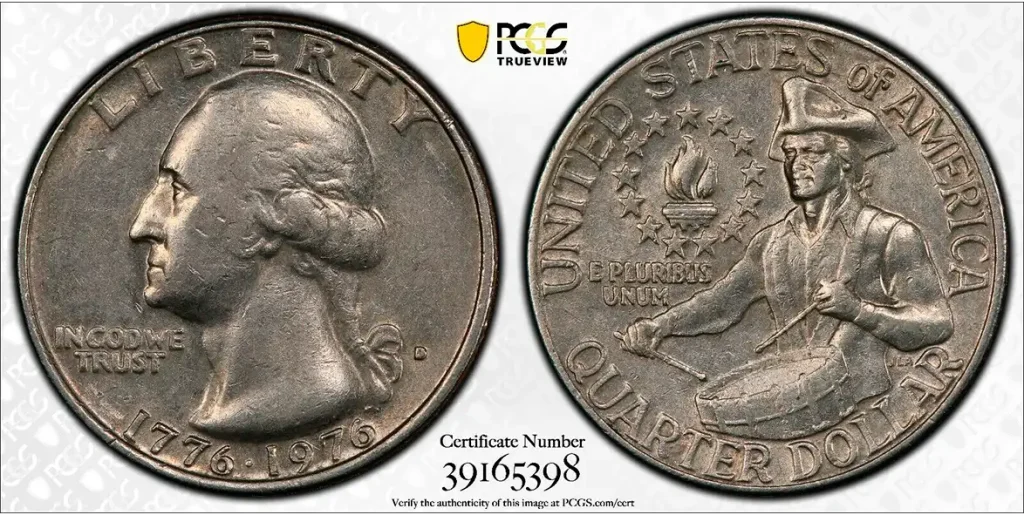
- Some 1976-D quarters show clear doubling in the date and lettering on the obverse.
- Even low-grade examples can sell for $20–$235.
- In MS65, these coins have reached $3,250, and the finest known MS66 example recently sold for $8,400.
- If you see a quarter where the date or inscriptions appear “shadowed” or doubled, this is a coin worth getting authenticated and graded.
Double Denomination (Struck on a Dime Planchet)
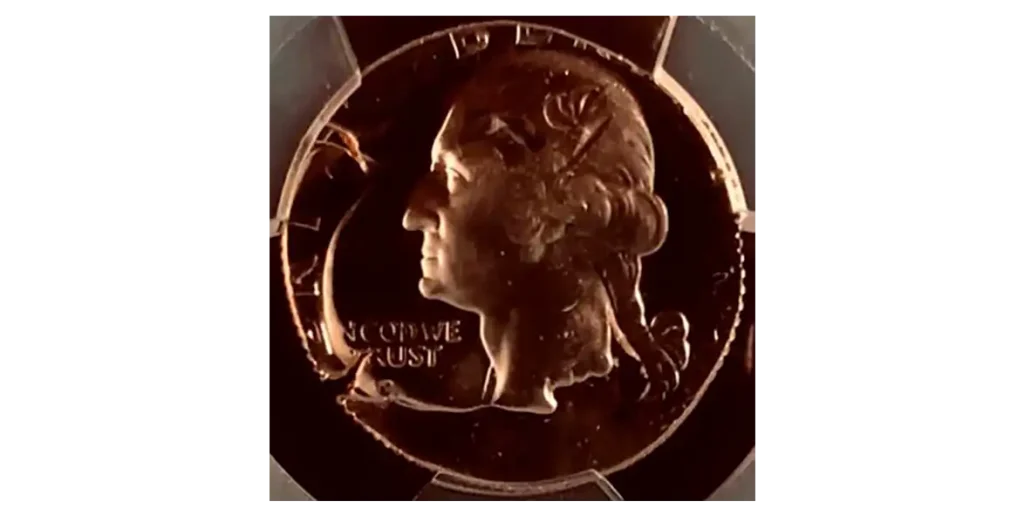
- One of the most dramatic errors, this occurs when the quarter design is mistakenly struck on a dime planchet.
- The result: a smaller coin with portions of the design missing.
- A known example sold for an impressive $9,200 in 2020.
Double Clip Error
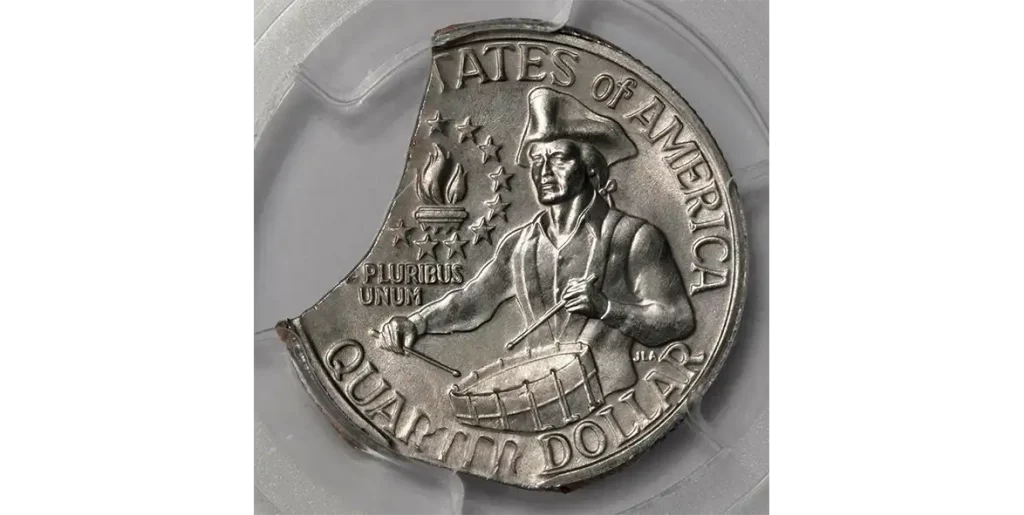
- Caused by the coin blank (planchet) being improperly punched.
- The result is a coin with two distinct areas—elliptical and straight clips—where metal is missing.
- One such coin sold for $89 in MS62, with more severe examples capable of bringing higher premiums.
Ultra-Rare Mule and Transitional Metal Errors
- These are the stuff of numismatic legend. While there is no confirmation, it keeps being an extremely impressive rumor worth mentioning.
- Rumored coins include:
- Bicentennial quarters struck with mismatched dies (mules).
- Quarters struck on experimental or transitional planchets—possibly even in wrong metals.
- Unverified claims suggest such a coin could be worth up to $250 million, though no verified public sale has confirmed this yet.
- If you discover a highly unusual Bicentennial quarter, always have it professionally authenticated to reach a suitable rare bicentennial quarters value.
Most Valuable Bicentennial Quarters: Auction Highlights
Here are some of the top examples of how much are bicentennial quarters worth. Finding a gem like this in your change jar is extremely rare but still not impossible.
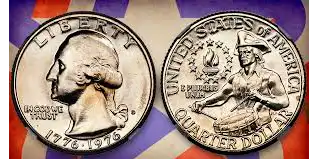
| Coin / Error Type | Auction Price / Value | Notes |
| 1976-S Silver Proof Bicentennial Quarter (PR-69 DCAM) | $19,200 | Highest auction price ever recorded for a silver proof quarter. |
| 1976-S Silver Proof Bicentennial Quarter | $13,500 (2019) | Another impressive high-grade silver proof sale. |
| Double Denomination Quarter (Struck on a Dime) | $9,200 (2020) | Rare and dramatic error: quarter design struck on dime planchet. |
| 1976-D Clad Doubled Die Obverse (FS-101, MS-66) | $8,400 (2023) | Dramatic doubling in the date and lettering; rare in high grade. |
| 1976-D Clad Regular Strike Quarter (MS-68) | $6,463 (2017) | Top-pop regular strike clad quarter, exceptional condition. |
| 1976-S Clad Proof Quarter (PR-70) | $6,038 (2010) | Perfect PR-70 proof grade, extremely rare and highly desirable. |
| 1976-S Silver Proof Deep Cameo Quarter | $2,760 (2007) | High-grade deep cameo contrast quarter. |
| 1976 Clad Regular Strike Quarter (MS-67) | $1,821 (2023) | High-grade regular strike; very difficult to obtain in MS-67+. |
| 1976-D Quarter, Double Clip Error (MS-62) | $89 (2004) | Planchet with both elliptical and straight clips; a rare curiosity. |
| Ultra-Rare Mule, Transitional Metal, or Extreme Double Die | $250 million (reported, unverified) | Legendary coin rumored to exist—claims remain unverified. |
How to Identify Rare Bicentennial Quarters
If you are wondering is bicentennial quarters worth anything while holding one in your hand, here is a guide for you. Not all rare Bicentennial quarters advertise their value at first glance. The following guide will help you examine your coins and find out how much is bicentennial quarters worth — it might be significantly more than you think.
1. Check the Mint Mark:
- “S” mint mark → Potentially silver (always verify weight).
- No mint mark (Philadelphia) → Common clad, but some error coins exist.
- “D” mint mark (Denver) → Slightly less common, watch for errors.
Tip: Use a magnifying glass or jeweler’s loupe to clearly view the mint mark, typically located to the right of Washington’s ponytail on the obverse.
2. Weigh the Quarter:
Accurate weighing can quickly separate silver quarters from their clad counterparts.
| Weight | Composition |
| 5.75 grams | 40% Silver |
| 5.67 grams | Standard Clad |
Investing in a precise digital scale is one of the simplest ways to detect silver quarters hiding in your collection.
3. Look for Errors:
Errors can dramatically increase a Bicentennial quarter’s value. Here are the most sought-after types:
- Doubled Dies (DDO/DDR)
Look for doubling on letters, numbers, and the colonial drummer design. Doubling can be subtle, so careful inspection is key. - Off-Center Strikes
Quarters with partial or off-center designs are highly collectible. The more dramatic the misalignment, the more valuable the coin can be. - Missing Mint Marks
An extremely rare and valuable variety is the No-S Proof Bicentennial quarter—proof coins that should display an “S” mint mark but were struck without one. Authenticated examples can fetch thousands of dollars.
4. Grading Condition:
Condition (or grade) plays a critical role in determining value:
| Grade | Characteristics |
| Circulated | Signs of wear, scratches, reduced luster. Usually face value unless an error is present. |
| Uncirculated (MS-60 to MS-69) | No wear, full mint luster. Higher MS grades (MS-67, MS-68, MS-69) can bring substantial premiums. |
| Proof (PR-65 to PR-70) | Mirror-like finish, struck on specially prepared dies. PR-69 and PR-70 examples are prized by collectors. |
Having your coins professionally graded by services such as PCGS or NGC can unlock their full market value. In high grades, Bicentennial quarters transition from simple collectibles to highly desirable investment pieces.
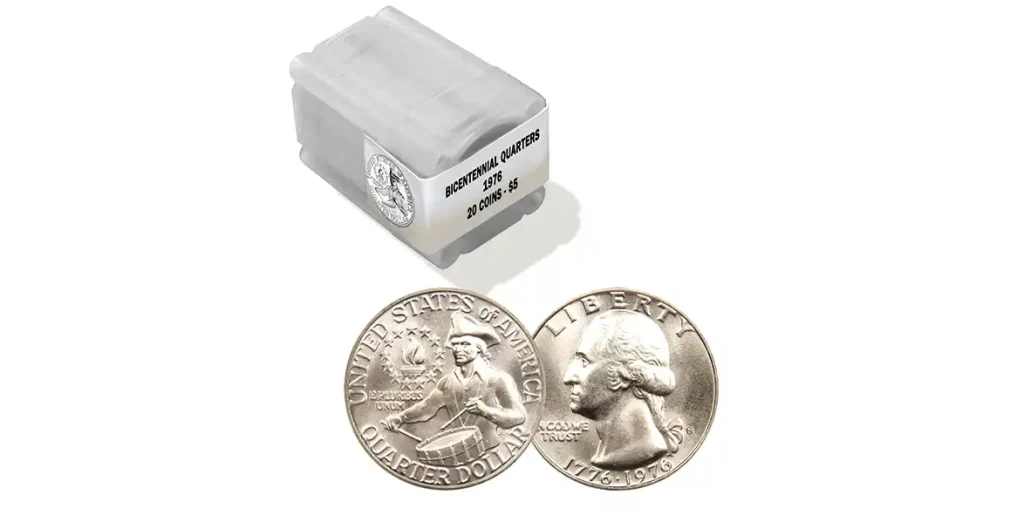
5. Use Modern Technologies
Professional grading is not cheap, and you should use it only for coins that seem promising. But how do you distinguish them from ordinary ones? Here is a tip for you — use a Coin ID Scanner in your smartphone before visiting a grading specialist.
With an AI-based identifying algorithm, it compares your coin with a vast database of real-world examples to identify it precisely. Then, it gives you current market data on your coin, as well as composition, historical background, and other data.
If you are just starting your way in numismatics, this tool is an essential one to save your time and provide you with simple access to previously hardly rescued data. And if you are going to sell or buy some coins, it will give you a fair look at the market situation for a better outcome.
FAQ
How rare is the 1976 No-S proof quarter?
Extremely rare. A verified No-S Proof Bicentennial quarter is a numismatic treasure worth thousands of dollars. If you suspect you have one, submit it immediately for professional grading and authentication.
Can I find silver Bicentennial quarters in circulation?
It is highly unlikely but not impossible. Most silver Bicentennial quarters were sold in collector sets and are seldom found in circulation today. Still, occasional finds occur, especially from coins that were spent unknowingly.
Should I clean my old quarters?
Never clean your coins—even light cleaning can cause microscopic scratches that dramatically reduce value. Serious collectors prefer coins in their original, unaltered state.
What’s the best way to store valuable quarters?
Use acid-free coin holders or archival-quality flips. Store your coins in a cool, dry place away from direct sunlight to prevent tarnishing or environmental damage.

Key Takeaways
As we’ve explored, 1776-1976 Bicentennial quarters offer both historical significance and surprising collectible potential. While most of these coins remain common, a savvy collector knows what bicentennial quarters are worth money, key signs and characteristics to look for.
Here are the most important points to remember:
- Most Bicentennial quarters are worth $0.25–$1 in circulated condition.
- Silver “S” mint quarters (weighing 5.75g) are worth $3–$25+ depending on condition and grade.
- Error varieties—including No-S Proofs, Doubled Dies, and off-center strikes—can fetch between $500 and $20,000 or more when authenticated and in top condition.
- Always check for:
- Mint marks (look for “S” to indicate silver).
- Weight (use a digital scale).
- Errors and conditions (careful visual inspection and professional grading can reveal hidden value).
Given that millions of these quarters remain in circulation, the hunt is far from over. With the right knowledge and tools, anyone can potentially uncover a hidden treasure among their pocket change or inherited coin collection.
